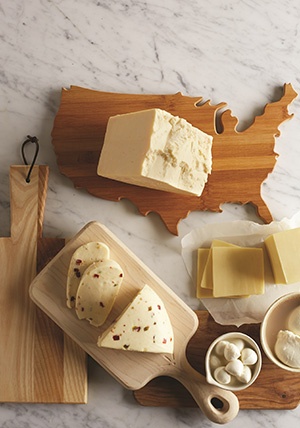-
Cheese Helping Foodservice Thrive
By Angelique Hollister April 13, 2017- Tweet
 The global appetite for cheese is expanding. Cheese consumption accounts for a reported 13% of global dairy consumption and is increasing at a rate of approximately 2% each year.1 The U.S. dairy industry is adequately prepared for this demand thanks to its rising, year-round, milk production capacity and ever-expanding portfolio of more than 600 cheese types. As an integral part of many regional and national cuisines, U.S. cheese is key to successful offerings that meet the health and taste needs of consumers.
The global appetite for cheese is expanding. Cheese consumption accounts for a reported 13% of global dairy consumption and is increasing at a rate of approximately 2% each year.1 The U.S. dairy industry is adequately prepared for this demand thanks to its rising, year-round, milk production capacity and ever-expanding portfolio of more than 600 cheese types. As an integral part of many regional and national cuisines, U.S. cheese is key to successful offerings that meet the health and taste needs of consumers.What better sector to take advantage of cheeses’ popularity and the U.S. dairy supply than the foodservice and prepared foods industry?
Unique Brunch Offerings Rise with Cheese Consumption
We have seen quick-service restaurants (QSR) and full-service restaurants (FSR) either support all-day breakfast or offer more, out-of-the-box offerings. This is largely responsible to the changing culture of brunch. It has become a weekend tradition for younger and older generations alike, and cheese plays an important part of the originality of each dish. Traditionally, items like omelets, bagels and breakfast sandwiches incorporated cheese. Now, we are seeing more experimentation, with hash browns, waffles, croissants and crunchier breakfast items2 using more artisanal cheeses such as gouda, colby and monterey jack, to provide ethnic tastes.
Snack or Appetizer? Mini-Meals Tout Convenience
Consumers eat when it fits in their schedule, no matter where they are. The line between snacks and meals has become blurred; mini-meals are served as snacks and snack foods served as meals.3 This shift in eating patterns creates mealtime fragmentation and an opportunity to craft unconventional menu items. Creative uses of regular meal items combine with small-portion, hand-held options to help restaurants meet consumers’ on-the-go needs. Items such as bite-sized snack wraps, portable cheese pairings, mozzarella sticks and cheese dips (soft-fresh cheeses), for items like pretzel bites, are just a few examples.
Simple, Convenient Lunch Items Attract Larger Crowds
Consumers are turning to healthier choices for a light and refreshing lunch. In response, the QSR and FSR segments now feature numerous salads, sandwiches and soups. A wide variety of U.S. cheeses (cubed or crumbled), such as monterey jack, pepper jack, provolone, smoked gouda and blue, are well-suited for salads and atop sandwiches. Ranch and blue cheese are used in dressings. Cream cheese and parmesan-based dips, like spinach and artichoke, feature fontina, pepper jack and sharp cheddar. Even comfort foods like grilled cheese4 and soups garnished or based in cheese (such as cottage cheese, ricotta, or cheddar) are making large menu appearances.
The Experience Generation Wants Adventurous Dinners
Consumers are spending less on durable goods and more on experiences like recreation, travel and eating out.3 Millennials, an adventurous group, are looking for meals that match their ambition for cultural experimentation. U.S. cheeses can provide this flavor as melted or crumbled on meats, stuffed in baked dishes and as sauces. Intensely-flavored cheeses, such as blue, feta, parmesan, Romano and gorgonzola, can provide zest without excess calories. But the one item that is increasing its dominance is pizza. Pizza is the single biggest use of cheese in foodservice and continued growth is expected as more gourmet options are created. Mozzarella-based pizza that incorporate intense cheeses, such as provolone, monterey jack and cheddar provide a high scale feel.
Download our U.S. cheese manual as a guide to which cheeses are best for each application.
As cheese consumption increases, taste preferences intensify and dishes become more nutritious, elaborate and specific to time of day. As production of specialty cheese continues to be the U.S.’s fastest-growing and most award-winning segment, the U.S. is ready to support the foodservice and prepared foods industry as they deliver on these demands.
1FoodBev. Cheese – Global Production and Consumption Trends. June 17, 2016. http://www.foodbev.com/news/cheese-global-production-and-consumption-trends/
2Eustacia Huen. Forbes. 5 Top Food Trends You’ll See in 2017. November 30, 2016. https://www.forbes.com/sites/eustaciahuen/2016/11/30/5-food-trends-youll-see-in-2017/#4daca1a35fc1
3Sharon Hoeting. General Mills. Changing Food Culture Gives Rise to New Opportunities with Snacks. July 15, 2016. https://www.generalmillscf.com/blog/all/changing-food-culture
4 Jeremy Quittner. Fortune. Why Americans Are Spending more on Experiences vs Buying Stuff. September 1, 2016. http://fortune.com/2016/09/01/selling-experiences/
Most Popular Posts
Find by Date, Geography and Dairy Product
- September 2015 (6)
- December 2015 (5)
- September 2016 (5)
- December 2016 (5)
- June 2017 (5)
- February 2015 (4)
- March 2015 (4)
- April 2015 (4)
- May 2015 (4)
- June 2015 (4)
- July 2015 (4)
- November 2015 (4)
- January 2016 (4)
- March 2016 (4)
- June 2016 (4)
- August 2016 (4)
- October 2016 (4)
- November 2016 (4)
- February 2017 (4)
- March 2017 (4)
- April 2017 (4)
- November 2013 (3)
- October 2015 (3)
- February 2016 (3)
- April 2016 (3)
- May 2016 (3)
- July 2016 (3)
- January 2017 (3)
- May 2017 (3)
- July 2017 (3)
- August 2017 (3)
- September 2017 (3)
- October 2014 (2)
- August 2015 (2)
- October 2017 (2)
- December 2017 (2)
- July 2020 (2)
- December 2013 (1)
- February 2014 (1)
- June 2014 (1)
- August 2014 (1)
- September 2014 (1)
- November 2014 (1)
- November 2017 (1)
- January 2018 (1)
- February 2018 (1)
- May 2018 (1)
- June 2018 (1)
- July 2018 (1)
- August 2018 (1)
- September 2018 (1)
- October 2018 (1)
- November 2018 (1)
- February 2019 (1)
- March 2019 (1)
- April 2019 (1)
- July 2019 (1)
- October 2019 (1)
- March 2020 (1)
- April 2020 (1)
- June 2020 (1)
- October 2020 (1)
- November 2020 (1)
- March 2021 (1)
- April 2021 (1)
- June 2021 (1)
- August 2021 (1)
- February 2022 (1)
- June 2022 (1)
- September 2022 (1)
- October 2022 (1)
- November 2022 (1)
- February 2023 (1)
- April 2023 (1)
- USDEC Staff (65)
- Kara McDonald (24)
- Terri Rexroat (15)
- John Klees (15)
- Kristi Saitama (9)
- Angelique Hollister (8)
- Vikki Nicholson-West (8)
- Shannon Koski (8)
- Rohit Kapoor (3)
- Keith Meyer (2)
- Moises Torres-Gonzalez (2)
- Amy Foor (2)
- Alan Levitt (1)
- Tom Vilsack, President and CEO (1)
- Allison Guzman (1)
- Dacia Whitsett-Morrow (1)
- Ryan Hopkin (1)
- Matthew Pikosky (1)
- Ross Christieson (1)
- Nina Halal (1)
- Mary Wilcox (1)
Keywords
- 2018 beverage trends (3)
- 2018 Food Innovations (1)
- 2018 food trends (3)
- Asia (1)
- Avian Influenza (1)
- Award-winning cheeses (3)
- Awards (2)
- Back-to-School (1)
- Baked Goods (1)
- Bakery (1)
- Beer (2)
- Beverage (5)
- Breakfast (1)
- Butter (6)
- Casein (2)
- Cheese (48)
- cheese flavors (2)
- Cheese Pairing (3)
- Cheesemaking (5)
- Child Nutrition (3)
- China (6)
- Clean Label (6)
- Common Food Names (1)
- Consistent Supply (3)
- Consumer Insights (48)
- Consumer Promotional Tools (1)
- Consumer Trends (15)
- Contest (1)
- craft foods (2)
- Cultured dairy (1)
- Dairy (17)
- Dairy Detective (4)
- Dairy Fat (1)
- Dairy Futures and Options (3)
- Dairy Ingredients (82)
- Dairy Ingredients Symposium (1)
- Dairy Permeate (1)
- Dairy Product Solids (1)
- Dairy Production (5)
- Dairy Proteins (35)
- Dairy Resources (23)
- Dairy Trade (1)
- Dairy Trends (10)
- Dessert (1)
- Digestive Health (2)
- Donna Berry (1)
- Drinkable yogurt (1)
- Early Childhood Development (1)
- Educational Tools (1)
- Egg Replacement (2)
- Egg Substitution (1)
- Egypt (1)
- Energy (4)
- Environment (2)
- Europe (1)
- Export Data (8)
- Exports (7)
- Farming (1)
- Flavor Trends (1)
- Follow-on Formula (1)
- Food Aid (2)
- Food and Beverage Trends (7)
- Food Production (3)
- Food Technology (3)
- Foodservice (2)
- Free From Claims (1)
- Full-fat Dairy (1)
- Geographical Indications (GIs) (1)
- GHG (1)
- Global (74)
- Global Dairy Market (2)
- Global Demand (2)
- Global Market (4)
- Global Supply (1)
- Greek Yogurt (1)
- Gulfood (2)
- Gut Health (1)
- Health (1)
- Healthy Aging (8)
- Healthy Indulgence (1)
- Heavy Cream (1)
- High Quality Protein (11)
- Holiday Dessert (2)
- Holidays (1)
- IFT (7)
- IFT2016 (1)
- IFT2018 (2)
- Infant Formula (1)
- Infographic (3)
- Innova Market Insights (4)
- Innovation (2)
- Japan (7)
- Lactose (8)
- Lactose-free (1)
- LinkedIn (1)
- Malnutrition (2)
- Market Insights (67)
- Methane (1)
- Mexico (2)
- Micellar Casein (3)
- Middle East (2)
- Middle East/North Africa (9)
- Milk (8)
- Milk Permeate (2)
- Milk Powder (10)
- Milk Protein (19)
- Milkfat (5)
- Millennials (3)
- MPC (4)
- MPI (1)
- Muscle Maintenance (1)
- Muscle Recovery (2)
- Muscle Synthesis (2)
- NAFTA (1)
- New Product Introductions (1)
- New Year's Resolutions (1)
- Nonfat Dry Milk/Skim Milk Powder (4)
- Nutrition (21)
- Nutrition Research (14)
- Obesity (1)
- Overnutrition (1)
- Permeate (19)
- Price Volatility (2)
- Probiotics (2)
- Product Innovation (3)
- Protein (33)
- Prototypes (1)
- Record (3)
- Reduced-Fat (1)
- Research & Data (1)
- Resources and Tools (8)
- Risk Management (3)
- RTD Coffee and Tea (1)
- Salon Culinaire (1)
- Salt Substitute (1)
- Savory Flavors (1)
- Science and Research (3)
- Service Providers (1)
- Simple Ingredients (1)
- Singapore (1)
- Skimmed Milk Powder (2)
- Smoothies (1)
- Snack Trends (3)
- Snacking (4)
- Snacks (1)
- Sodium (3)
- Sodium Reduction (4)
- South Korea (3)
- Southeast Asia (9)
- Sports Nutrition (4)
- Stewardship (1)
- Student Competition (1)
- Supplier Directory (1)
- Supply (4)
- Sustainability (7)
- Sustainability Awards (1)
- Sustainable Nutrition (7)
- Technology (1)
- ThinkUSAdairy (2)
- Toddler Formula (1)
- Trade Data (1)
- U.S. Dairy Industry (11)
- U.S. Dairy Industry Growth (6)
- U.S. Dairy Partnerships (4)
- U.S. Dairy Products (15)
- UK (1)
- United Arab Emirates (5)
- United States (10)
- USDEC Events (44)
- Value (3)
- Vietnam (5)
- Volatility (1)
- Volume (4)
- Waste Reduction (1)
- Weight Management (6)
- Whey (14)
- Whey Ingredients (3)
- Whey Permeate (5)
- Whey Products (3)
- Whey Protein (47)
- Whey Protein Concentrate (3)
- Whey Protein Isolate (5)
- Whole-milk dairy (1)
- Wine (2)
- World Championship Cheese Contest (1)
- World Cheese Awards (2)
- World Milk Day (1)
- WPC (4)
- WPI (1)
- Yogurt (6)


